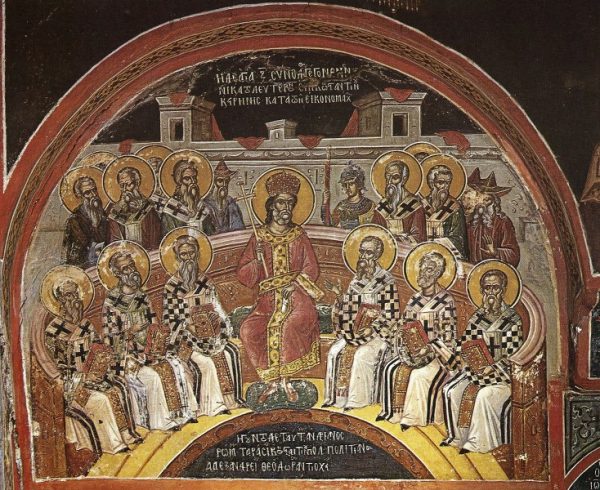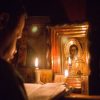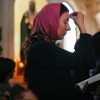Today in the Orthodox Church we commemorate the Fathers of the Seventh Ecumenical Council that assembled in the city of Nicaea in the year 787 ad to resolve the issues and controversies around the veneration of icons and those who had tried to outlaw and ban them from the churches.
In our Introduction to Orthodoxy classes one of the aspects of the faith that we talk about are the sources of authority within the life of the Church. Is the only source of authority the Bible or do other sources exist? It becomes clear to anyone who studies just bit of church history that the Bible is not the only source of authority. Other sources exist to clarify and to expound upon the words of Holy Scripture and the New Testament. One source of authority within the Church is the bishops themselves as they gathered together in prayer and with the guidance of the Holy Spirit in these ecumenical councils, in order to lead and guide the Church through difficulties especially those of a doctrinal nature. When anyone picks up and reads from the Old Testament Scripture or the New Testament, he can very easily misinterpret or misunderstand the text. He or she can even twist the text and convince themselves and others of this novel or incorrect reading. Yet the Church reminds us that it has certain safeguards in place in order to avoid such issues. Even the Apostle Peter tells us that no Scripture is of private interpretation, but is subject to the greater community. Likewise the bishops of the church are not islands unto themselves, they are responsible to one another and to the whole of the Christian community. Each is accountable to the other and all of them as members of the body of Christ become keepers of the sacred traditions and teachings of the Church as they have been passed down to us. I am not quite sure how I can awaken you to the amazing gift that you have been given through the Church and through her faithful “passing down” or traditioning of our sacred faith, but I will share some of the words of Fr. Alexander Schmemann to emphasize the point. He says,
““Orthodoxy,” “the true faith”; if for one moment we try to understand what it means: the true, the full Christianity, as it has been proclaimed by Christ and His disciples; if our Church has preserved for all ages the message of the apostles and of the fathers and of the saints in its purest form, then, my dear friends, here is the answer to the questions and to the problems and to the sufferings of our world. You know that our world today is so complex. It is changing all the time. And the more it changes, the more people fear, the more they are frightened by the future, the more they are preoccupied by what will happen to them. And this is where Orthodoxy must answer their problem; this is where Orthodoxy must accept the challenge of modern civilization and reveal to men of all nations, to all men in the whole world, that it has remained the force of God left in history for the transformation, for the deification, for the transfiguration of human life.”
The Church commemorates the fathers of the ecumenical councils because they have upheld and protected the life giving faith for us and that is the greatest victory that we can have as Christians. St. John the Theologian writes, “And this is the victory that has overcome the world— our faith.” (1 Jn 5:4)
According to Christian faith, the crucifixion and the resurrection of Jesus Christ are the most important events in the entire history of the universe. Yet, in order for them to be understood as more than myth or legend, something must anchor them to reality. What the Church has understood as the anchor of our faith is the eye witness accounts of the apostles. They gave up their lives, they went to their deaths preaching and teaching that they had indeed seen and touched and heard and known the Son of God, the second person of the Holy Trinity.
Icons, according to the fathers of the 7th council, are a necessary part of all Christian worship. In our Church, we pray what we believe and we believe what we pray. The Orthodox faithful underwent many years of hardship and persecution at the hands of those who believed that the use of icons was forbidden and was wrong according to their understanding of Scripture (an understanding that incidentally was heavily influenced by the rise of Islam). These Christians read Scripture with a narrow understanding that denied the living experience of the universal Christian church of the early centuries. Nevertheless, truth won the day.
The 7th ecumenical council, a universal council of the east and the west, tells us that icons are not only good, but absolutely necessary. They are a continual reminder that God is no longer understood as simply an invisible spirit. God is understood as having a Son, who Himself took real human flesh, real human existence. Who was born on an actual day in history, in an actual place, with an actual human mother from whom He received His actual human DNA. St. Peter writes “For we did not follow cleverly devised myths when we made known to you the power and coming of our Lord Jesus Christ, but we were eyewitnesses of his majesty.” 2 Peter1:16
In the Old Testament, God forbid the making of images for worship because the people did not have a proper understanding of Him. No one had ever seen God, for God is spirit. For the people to attempt to depict or worse yet, to pray to what they had not seen or understood, would be a great blasphemy because they were bound to depict God incorrectly. They were bound to worship something false. But, the Lord Jesus tells the Samaritan woman that the day is coming when the true worshippers of God will worship Him in spirit and in truth. This indeed has happened with the coming of the savior into the world. The Apostle Paul writes that Jesus Christ “is the image of the invisible God” (Col 1:15). His actual word from the Greek is not image but icon. It is this revelation of the Son of God in the flesh, that makes iconography not only proper, but necessary. Since mankind looked on the face of the Son of God and dwelt with Him and witnessed all of the events of His life, we know that He is real. To forbid iconography is to deny the incarnation, to deny the taking of flesh by the Son of God. The Church reminds us that what we believe is not myth, but truth, and truth has consequences.
God became man and dwelt among us. That is our Christian faith. It is not philosophical theory but experience that includes our senses. We don’t know God through books. We know God by experience. In the Orthodox faith we have a sensory experience every time that we enter the church. We taste the Lord’s body and blood, we smell the incense, we see and kiss the icons, we hear the hymns. It must be so! Because our redemption and healing happens not only on some far-away cosmic level, but it happens even within the individual person and within his very cells. Sanctification through the life of the Holy Spirit, transforms us at every level. As a person participates in worship,through the body, through their senses, they are healed. The Lord Jesus Christ in His abundant mercy and love for mankind, has made this healing possible by truly taking our human flesh and lifting it up to His level. His resurrection becomes our resurrection. Everything is healed. Everything is transformed. Everything is made new in the light of the incarnation and bodily resurrection of Jesus Christ.
This is why we remember the return of the icons into the Church. Because we can’t get to the resurrection without the incarnation. We can’t get to the life-saving faith unless the apostles had first witnessed the Word made flesh, and been so convinced of this fact that they were willing to die to proclaim this truth in Jesus Christ. It is a powerful testimony of the truth of our faith and it is this faith that gives us new life. It is this faith that we cling to and embrace as we live a life of repentance and prayer and ask the Lord to open our hearts and minds and make these truths a part of our being.
Each and every week at Matins we sing “God is the Lord and has revealed Himself to us.” Truly God is the Lord and has revealed Himself to us! Let us embrace the divine gift that has been shared with us through God’s grace and the witness of the Holy Fathers of the 7th council, and glory be to God forever, AMEN.

















